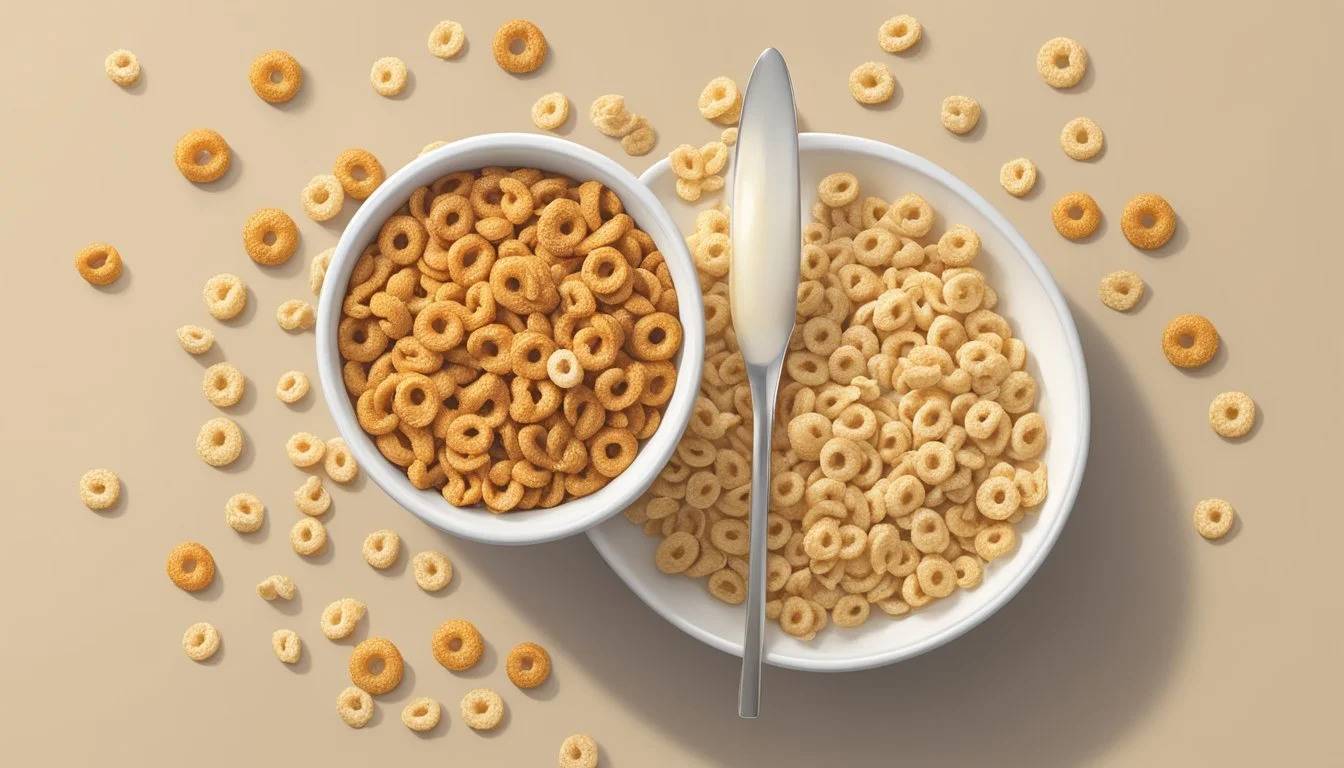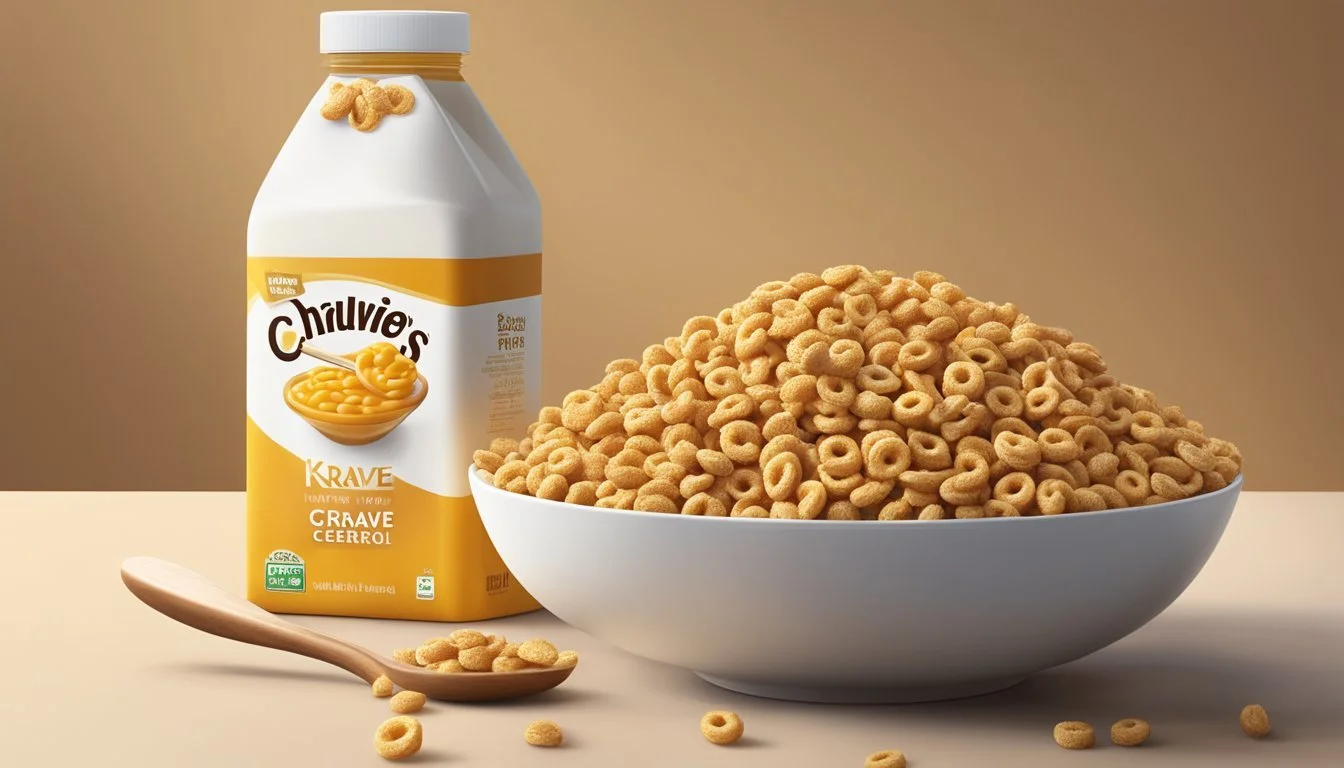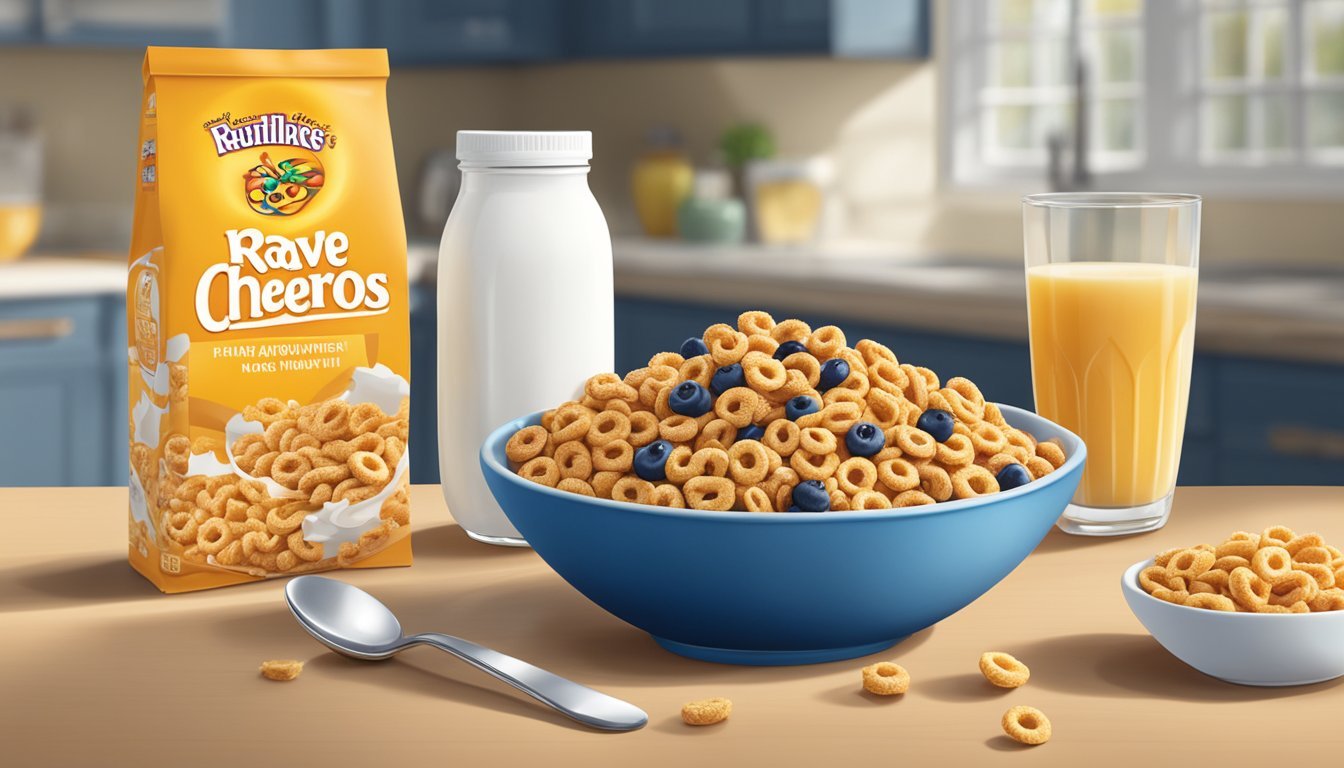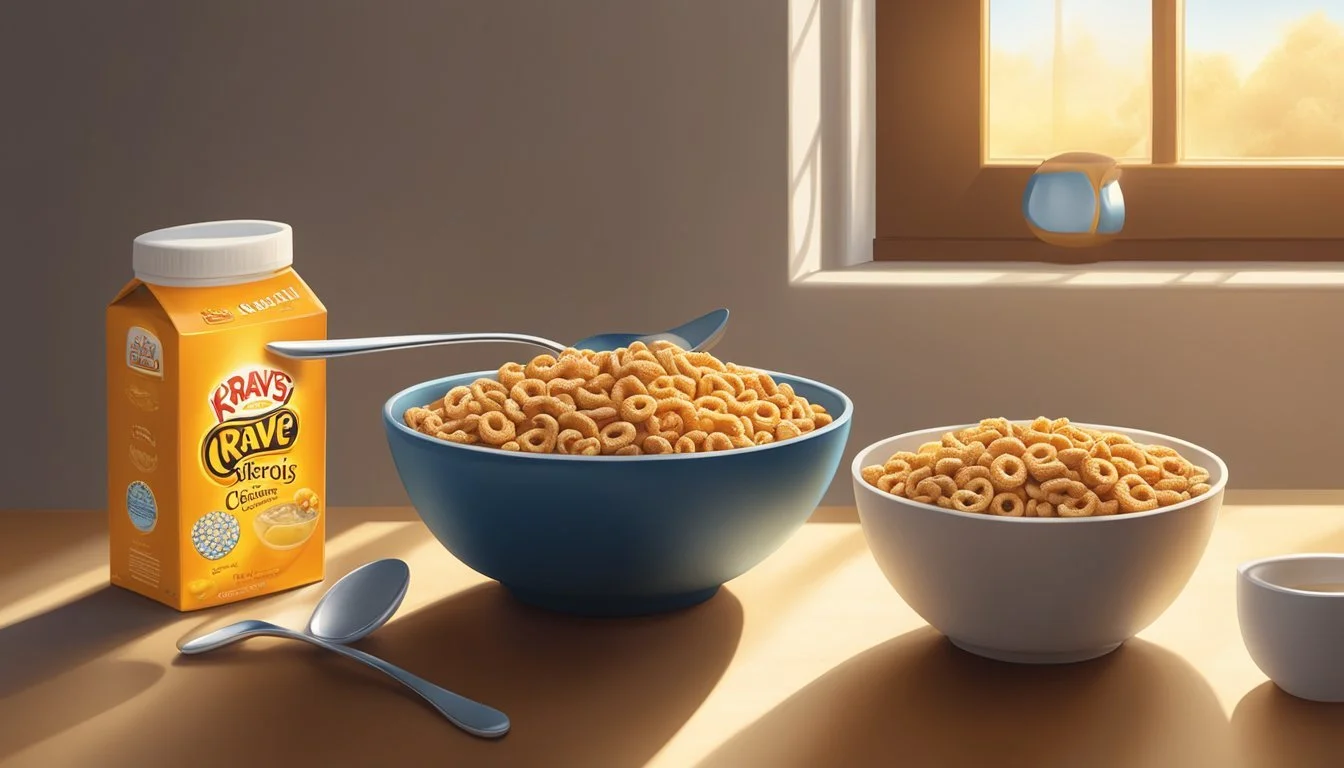Honey Nut Cheerios vs Krave
Comparing Nutritional Benefits and Taste
This Article is Part of Our Breakfast Cereal Guide with Details on Honey Nut Cheerios Nutrition and Krave Nutrition
Honey Nut Cheerios and Krave are two popular breakfast cereals that offer distinct experiences for the palate. Honey Nut Cheerios, a staple from General Mills, combines the wholesome goodness of oats with a hint of honey and almond flavor, making it a favorite for many seeking a slightly sweet yet healthy start to their day. On the other hand, Krave, a product by Kellogg's, is designed to appeal to those with a stronger sweet tooth, featuring crunchy cereal shells filled with rich chocolate.
For those prioritizing a healthier option, Honey Nut Cheerios may be the better choice. This cereal generally has lower sugar content and higher fiber due to its oat base, contributing to longer-lasting energy and satiety. In contrast, Krave tends to focus more on indulgence, providing a significant sweet kick that can be an occasional treat rather than a daily staple.
In terms of taste and texture, Honey Nut Cheerios offers a balanced sweetness and a satisfying crunch that's hard to beat for a morning routine. Krave, with its chocolate-filled centers, delivers a more decadent experience, which might be perfect for those specific moments when one desires somethingmore dessert-like. Comparing these cereals reveals that each has its place depending on whether one's breakfast priority is nutrition or indulgence.
Overview of Honey Nut Cheerios and Krave
Honey Nut Cheerios and Krave are both popular breakfast cereals with distinct attributes and compositions. This section explores their background, cereal composition, flavor profiles, and product variants.
Brand Background
Honey Nut Cheerios is made by General Mills, a major manufacturer of breakfast cereals, and has been a staple since its release in 1979. It is a variation of the original Cheerios, known for its distinctive honey flavor and added almond flavor.
Krave, on the other hand, is produced by Kellogg's and debuted in 2012. This cereal is renowned for its chocolate filling encased in a multi-grain shell, offering a unique and indulgent breakfast option. Kellogg’s is another leading name in cereal production, known for its wide array of cereal options.
Cereal Composition
Honey Nut Cheerios is made from a base of whole grain oats. It provides essential nutrients like fiber, protein, and important vitamins and minerals such as Iron and Calcium. It also contains added sugars to enhance its honey flavor.
Krave is composed of multi-grain ingredients including whole wheat and other grains, with a creamy chocolate center. It is higher in sugars to provide its signature chocolaty taste and contains vitamins and minerals, though typically in different proportions compared to Honey Nut Cheerios.
Flavor Profiles
Honey Nut Cheerios features a subtly sweet honey and almond flavor profile. The whole grain oats provide a mild, nutty background flavor. Though sweeter than the original Cheerios, it maintains a balanced taste which appeals to both adults and kids.
Krave is characterized by its rich, sweet, and intense chocolate flavor encased in a crunchy outer shell. The combination of grain texture and chocolate filling offers a unique taste experience. This cereal is often favored by those with a preference for chocolatey breakfast choices.
Product Variants
Honey Nut Cheerios has extended its line to include variants like Chocolate Cheerios, Chocolate Peanut Butter Cheerios, and Fruity Cheerios. These variants cater to diverse taste preferences while maintaining the essential nutrient profile that Cheerios is known for.
Krave also offers different variants such as Double Chocolate Krave and S’Mores Krave. These versions add variety to the original chocolate-filled cereal, catering to those seeking different levels of chocolate indulgence in their breakfast.
Both cereals have adapted over time to include these variants to meet the evolving preferences of their consumers.
Nutritional Comparison
When comparing Honey Nut Cheerios and Krave, key nutritional differences emerge in terms of caloric values, macronutrient profiles, and content such as sugar, fat, vitamins, and minerals. Each cereal offers distinct health benefits and drawbacks.
Caloric Values
Honey Nut Cheerios contains 140 calories per one-cup serving. In contrast, Krave has 120 calories per 3/4-cup serving. When normalized for a one-cup serving, Krave would contain approximately 160 calories, making it slightly more calorie-dense.
Cereal Calories per Serving Honey Nut Cheerios 140 Krave ~160
Macronutrients
Honey Nut Cheerios provides 3 grams of protein and 2 grams of dietary fiber per serving. On the other hand, Krave offers 2 grams of protein and 2 grams of dietary fiber, indicating that both cereals have similar fiber content but Honey Nut Cheerios has higher protein content.
Nutrient Honey Nut Cheerios Krave Protein (g) 3 2 Dietary Fiber (g) 2 2
Sugar and Fat Content
Honey Nut Cheerios contains 12 grams of sugar and 2 grams of fat per serving, including 0 grams of saturated fat. Krave, however, has 14 grams of sugar and 3.5 grams of fat, with 1 gram of saturated fat, suggesting higher sugar and fat content in Krave, especially saturated fat.
Component Honey Nut Cheerios Krave Sugar (g) 12 14 Fat (g) 2 3.5 Saturated Fat (g) 0 1
Mineral and Vitamin Content
Honey Nut Cheerios is fortified with essential vitamins and minerals including zinc, vitamin C, magnesium, and folic acid. While Krave also contains these nutrients, the quantities might vary. Specifically, Honey Nut Cheerios aims to provide a balanced mix of vitamins and minerals that can support daily nutritional needs more comprehensively.
Vitamin and Mineral Content:
Honey Nut Cheerios:
Zinc: 10%
Vitamin C: 10%
Magnesium: 6%
Folic Acid: 25%
Krave:
Zinc: 5%
Vitamin C: 5%
Magnesium: 2%
Folic Acid: 15%
In summary, when choosing between Honey Nut Cheerios and Krave, individuals should consider nutritional needs such as caloric intake, protein, dietary fiber, sugar, fat, and essential vitamins and minerals.
Dietary Considerations
When comparing Honey Nut Cheerios and Krave from a dietary standpoint, it is important to examine their nutritional content and compatibility with various dietary needs. These factors are crucial for individuals aiming to make healthier choices and those with specific dietary restrictions.
Healthier Options
Honey Nut Cheerios are often considered a more nutritionally balanced cereal due to their higher content of whole grains and fiber. A single serving typically contains 3 grams of dietary fiber and is made from whole grain oats, which contribute to heart health and better digestion.
Krave, on the other hand, is primarily made from refined grains and contains less fiber, usually 1 gram per serving. This makes Honey Nut Cheerios a preferable choice for those looking to increase their fiber intake and consume more whole grains.
In terms of sugar content, Honey Nut Cheerios have around 12 grams of sugar per serving, whereas Krave can contain upwards of 14 grams. Both cereals contain added sugars and should be consumed in moderation, especially for those watching their sugar intake.
Allergen and Diet Compatibility
Honey Nut Cheerios contain almond flavoring, which may pose a risk for individuals with nut allergies. However, they are gluten-free, making them suitable for those with gluten sensitivities or celiac disease.
Krave contains multiple allergens, including wheat and dairy, making it unsuitable for individuals with gluten intolerance or lactose intolerance. Additionally, Krave is not a viable option for those adhering to a vegan or dairy-free diet, unlike Honey Nut Cheerios, which do not contain any dairy ingredients.
It's essential to check the ingredient list and nutritional labels of each cereal to ensure they meet specific dietary needs and restrictions.
Consumer Experience
The consumer experience for both Honey Nut Cheerios and Krave encompasses various factors like texture, taste, and serving suggestions. Each cereal offers a unique flavor profile and caters to different personal preferences and breakfast routines.
Texture and Taste Experience
Honey Nut Cheerios offer a crisp texture that remains satisfying whether consumed dry or with milk. The honey flavor adds a subtle sweetness that many find appealing for a light yet tasty breakfast.
Krave, on the other hand, delivers a crunchy outer shell with a chocolate-filled center. This combination provides a rich and indulgent flavor experience that appeals to those with a sweet tooth.
Krave's texture can be denser compared to the airy and light feel of Honey Nut Cheerios, which some might find more satisfying.
Serving Suggestions
Honey Nut Cheerios are versatile and can be enjoyed in various serving sizes. They are often consumed with milk, highlighting their honey flavor, but can also be a convenient on-the-go snack.
Krave is typically enjoyed as a breakfast cereal with milk, with the milk complementing the chocolate filling perfectly. The richer flavor profile makes Krave a favored choice for those looking for a more indulgent breakfast option.
Both cereals can be used creatively, such as in cereal bars or as toppings for yogurt, providing flexibility in how they can be incorporated into one’s diet.
Purchasing Information
This section covers key aspects of purchasing Honey Nut Cheerios and Krave, focusing on prices, packaging details, and availability.
Price Comparison
The price of breakfast cereals can vary based on brand, packaging, and location. Honey Nut Cheerios typically cost between $3 to $4.5 for an 18-ounce box. Krave tends to be priced slightly higher, with a 11.4-ounce box often costing $4 to $5.
When considering bulk purchases, Honey Nut Cheerios generally offer better value with larger family-sized options often discounted. Krave boxes, while smaller, may frequently be found on promotional sales, affecting the cost per ounce.
Packaging and Serving Size
Packaging affects price and convenience. Honey Nut Cheerios generally come in larger boxes with serving sizes of 1 cup (approximately 1 ounce) per serving. Standard box sizes range from 18 to 27 ounces, making them suitable for families. Nutritional information is well-detailed on the packaging, aiding health-conscious consumers in making informed decisions.
Krave is often packaged in 11.4-ounce boxes with smaller serving sizes of 3/4 cup (30 grams). The smaller packaging may appeal to individuals or smaller households looking for variety without committing to large quantities. The vibrant packaging is designed to attract a younger audience, emphasizing its sweet and indulgent nature.
Availability and Popularity
Honey Nut Cheerios is widely available and can be found in almost every major grocery store across the United States. Its popularity over the years has made it a staple in many households, and it maintains a strong presence both in-store and online.
Krave, while also widely available, may sometimes be found in specialty or larger grocery stores. It enjoys significant popularity among younger consumers and those seeking a chocolatey cereal option. Despite its smaller niche, it often earns prominent placement in cereal aisles and online grocery platforms.
They both benefit from extensive marketing campaigns, helping maintain their visibility and demand among different consumer groups.
Conclusion
Honey Nut Cheerios and Krave both offer distinct flavors and nutritional profiles.
Honey Nut Cheerios are made with whole grain oats and real honey. Per serving, they provide 110 calories, 2 grams of protein, and 9 grams of sugar. These can be a healthy breakfast choice, especially for adults looking for essential vitamins and minerals.
Krave Chocolate Chip Cookie Dough Cereal boasts 170 calories per serving, with 4 grams of fat and 16 grams of sugar. This makes it a sweeter, higher-calorie option compared to Honey Nut Cheerios.
For those concerned about added sugar, Honey Nut Cheerios might be the better choice. On the other hand, Krave offers a more indulgent start to the day, possibly appealing to those with a sweeter palate.
Nutritional Comparison Table:
Nutrient Honey Nut Cheerios (1 cup) Krave (1 cup) Calories 110 170 Fat 1.5g 4g Sugar 9g 16g Protein 2g 2g
Both cereals offer unique attributes that cater to different tastes and nutritional requirements. The choice largely depends on individual dietary goals and preferences.
More on Honey Nut Cheerios
Cinnamon Toast Crunch vs Honey Nut Cheerios: Which is better?
Honey Nut Cheerios vs Kellogg's Apple Jacks: Which is better?
Honey Nut Cheerios vs Kellogg's Froot Loops: Which is better?
Honey Nut Cheerios vs Post GrapevsNut Flakes: Which is better?
Honey Nut Cheerios vs Post Raisin Bran Cereal: Which is better?






